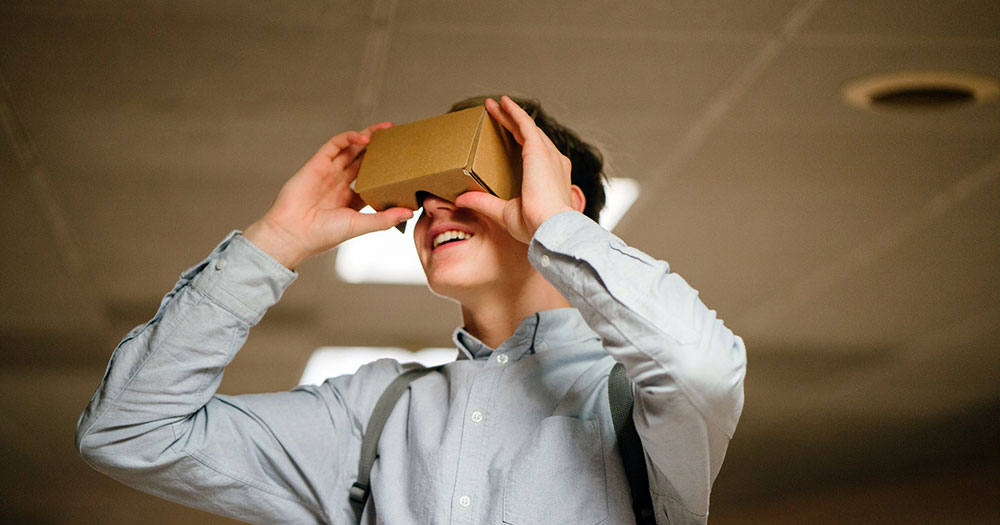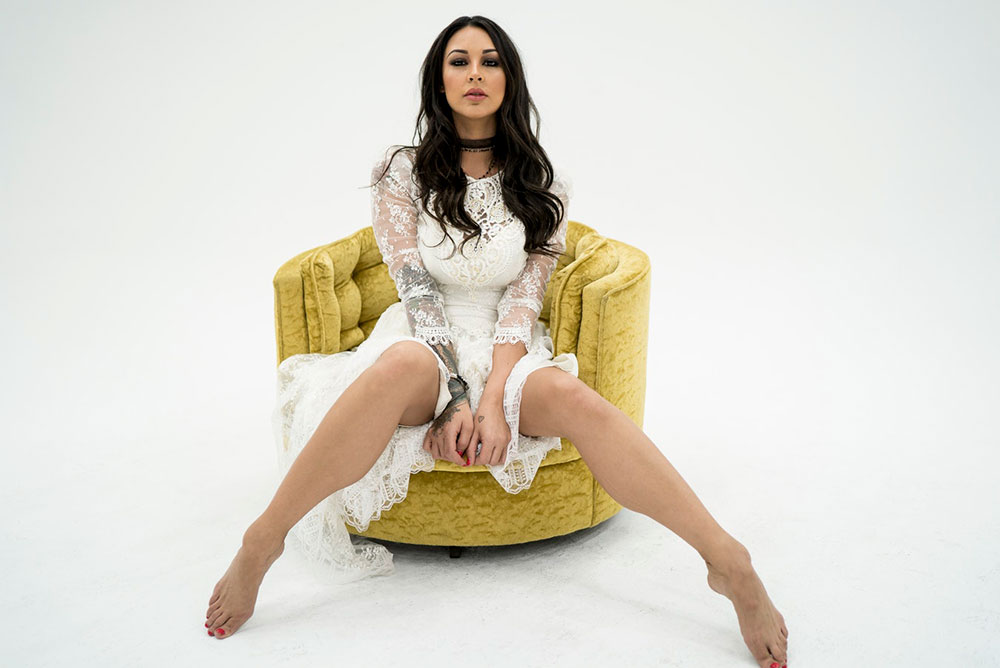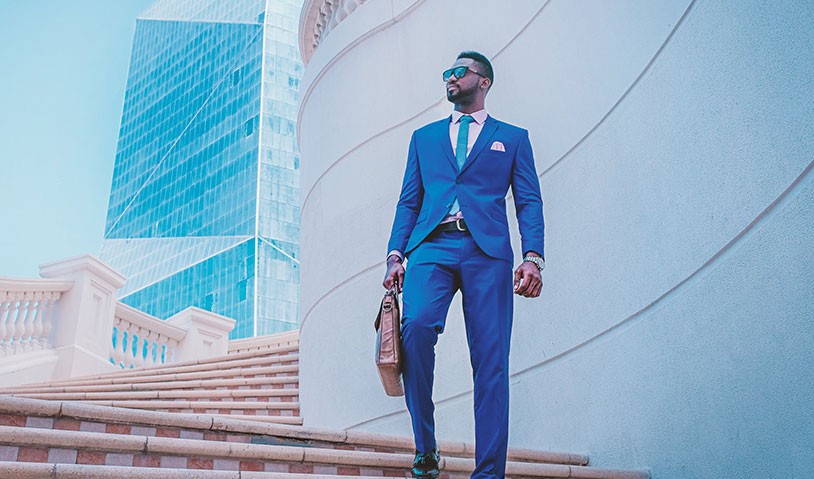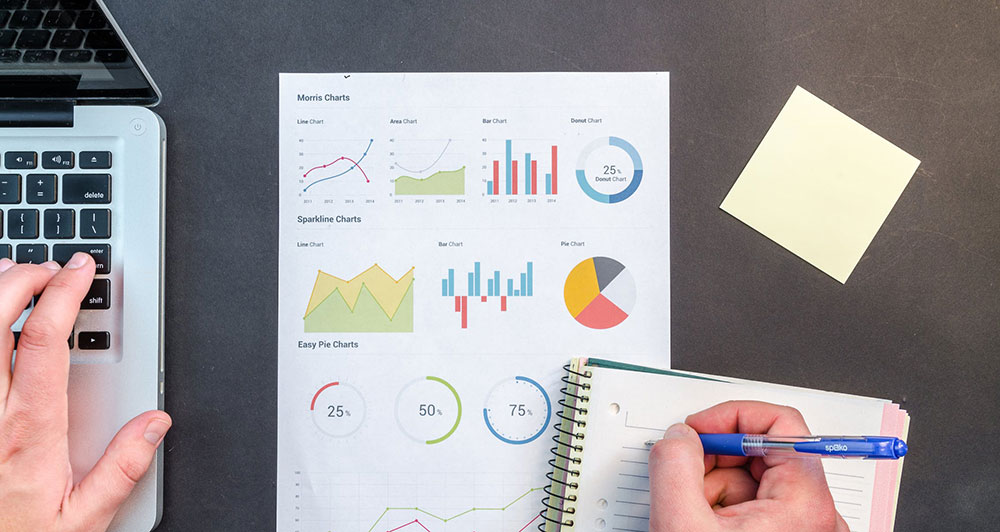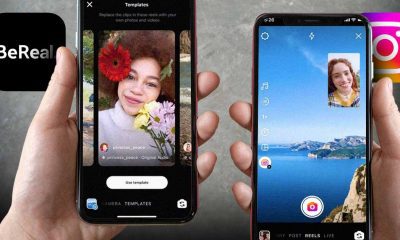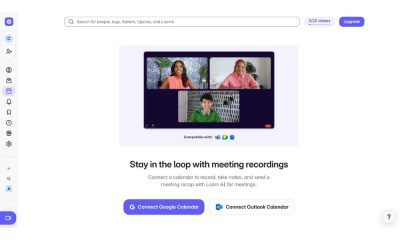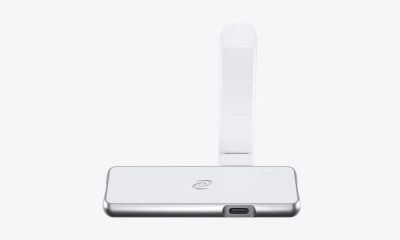Business
Entrepreneurship: A Millennial Definition
Published
6 years agoon

What is entrepreneurship? Well, The word entrepreneurship has easily been one of the most sought after lifestyles in modern history. Some people think that entrepreneurship automatically brings a life of lavish things, constant travel/exploration, internet fame, dating supermodels, and short working hours. But before you get all of these “things,” you just have to quit your job, sacrifice a few years of your life, and POOF. You get it all!
So, what are you waiting for? Go on and quit that job of yours. DO IT! It’s what you want, isn’t it?
Well, before you do all of that, I suggest learning more about the word entrepreneur. What is entrepreneurship and what does it truly mean? This article is a collection of thoughts that I have compiled into one beautiful love letter to the one word that has somewhat defined my life; entrepreneurship.
Let’s start with the basics
The business dictionary and most overused definition of entrepreneurship are defined as: “The capacity and willingness to develop, organize and manage a business venture along with any of its risks in order to make a profit.”
Now that we have the fundamental definition of what is entrepreneurship, we can further expand on the initial foundation. Like everything else, entrepreneurship is a journey. As Robert Frost eloquently uses a phrase in his poem “The Road Not Taken”:
“Two roads diverged in a wood, and I—I took the one less traveled by,And that has made all the difference.”
Entrepreneurship’s journey can be summarized in three particular phases:
Phase 1: Buzzwords
As a millennial, we can be easily influenced by outside internet celebrities. Famous figures like Gary Vaynerchuk, Tai Lopez, Grant Cardone, Lewis Howes, and John Lee Dumas. (Just to name a few) You watch their content on social media religiously, read about how they were able to become successful, and then begin to envision a life that is nearly identical or rather similar to theirs. You become so inspired that you begin creating content for your own social media platforms with cheesy motivational quotes from entrepreneurs of the past or worse, pictures of yourself with quotes said by you and then signed by you. As if you’ve accomplished something.
SIDE NOTE: Think about it. How many people do you know that not only posts a ton of motivational quotes but have added their own personal signature within the social media posts? We can thank Gary Vay-Ner-Chuck for this one.
The New Meaning of Entrepreneurship
The definition of entrepreneurship no longer has the same meaning. Currently, the definition of entrepreneurship is a person dealing with an egotistical battle of attention and primarily focuses on their own success and not the success of their team. A lonely journey of one’s self-validation.
At the beginning of your entrepreneurship journey, it’s easy to get lost in the world of business and it’s fun to fantasize about one’s self-success. We as a society are obsessed with it. Early on, identify the things that you most want in life. Is it fame? (And if it is, that’s totally cool. Just accept it and embrace it.)
Do you want to bring change in the world? Do you want to run a successful company?
Phase 2: Finding Yourself and Obtaining Balance
Understanding your why or at the very least having a general understanding of why you’re willing to be as crazy as you are, to quit your job to do the thing you love, is critical to one’s success. This fundamental understanding will allow you the ability to motivate yourself when times get tough and you feel like quitting.
Entrepreneurship is not fun. The highs are high (so high in fact) but the lows are depressingly low. It’s a constant roller coaster ride filled with non-stop ups and downs, twists and turns stop and goes. Strangely enough, those emotions will all be experienced in the first minute of your day. Your mind tends to wonder, you feel excited, trying to further expand on your initial ideas from your meeting today, thinking about what you may have done wrong to get that new client, or even experiencing the success of obtaining a new client! (If so, congrats!)
At the beginning of your entrepreneurship career, it’s important to understand yourself and the need for balance.
Balance
No one ever truly knows oneself in the earlier stages in life and especially their career. But what is important is to have empathy. Not only for your peers but also for yourself. It’s ok to fail. It’s ok to not be where you want to be, but be cognizant that one day, you will get to where you want to be.
Next is balance. It is so darn easy to work 20 plus hours a day. I still do it sometimes. But you need to find a way to let go of the computer and walk away from the work. Even if it’s for just an afternoon. Find a hobby, fall in love with something other than work, and find a way to be romantic to yourself. Your own mental well being will give you the superpowers to achieve your goals.
Phase 3: Execution and Persistence
The last piece of the puzzle and quite frankly, the most important part of entrepreneurship. You now have at least a few ideas as to what is entrepreneurship to a millennial.
Execution and persistence are the hardest of the three phases. It requires the most refining and also the most amount of attention. If I could do it all over again, (and there is no way that I would want to, because it led me to this moment of my life) I would be more data-driven. Passion can only get you so far, but there will come a point and time in the entrepreneurship journey that you need to go off of numbers, analytics, and raw data.
Being a more numbers driven organization will give you the know how to expand in the future. It will also give you the understanding of how you and your team may not have been executing. The best part about plans is that they change. But without the proper data and numbers, it’s almost impossible to make an educated decision to pivot or shift your company without having that information. If you feel the need to learn more about entrepreneurship and want is entrepreneurship to other millennials, you can get advice from other millennials here. Written by a colleague of mine that influenced and inspired this article. learn what others
Tips for The Entrepreneur Mind
- Have A General Understanding Of Your Mission And Why: It’s ok if you do not have it all figured out. However, there is a general theme of what you believe in as a person. If you don’t have the next 25 years figured out to a “T’ it’s ok. Jot whatever comes to mind in your head on paper and get it out there throughout the universe.
- Treat Your Company Like A Sports Team And Not A Family: I learned this from Tim Ferris’ podcast with Reid Hoffman. Check it out.
- Show Empathy: Don’t be a robotic D-Bag. Give a crap about others.
Tips For The Entrepreneur At Home
- Read Books And A Lot Of Them: I compiled a list of entrepreneur resources on my podcast that has a list of the most influential books that I have personally read. Head over to a Barnes and Noble and pick out books to read. There is a reason those books are located in that store. They are trusted, edited, and have the reputation of a quality story teller. My rule of thumb is that if it’s in a B&N and has been recommended for me to read, then it’s a book I need to read.
- Stop Reading And Watching Content From Untrusted Or Unverified Resources/Publications: The amount of articles that are available online (especially this one) can completely derail or disrupt your day. Do not become easily influenced by content. Stay true to yourself and your mission.
- Leave Your Ego At Home: You are not bigger than anyone else on your team and you are certainly not bigger than your company. Don’t be comfortable with being the CEO of your company. Early on in your startup, a title is just a title. You can be called manager or even janitor, but what truly matter is does your team listen and follow your vision.
- Understand Your Strengths And Go ALL In Once You Find Out What They Are: Once you have a general understanding of your strengths, then find out what your weaknesses are. Then hire individuals that can help fill that area.
Tips For The Entrepreneur At Work
- Understand Your Strengths And Go ALL In Once You Find Out What They Are: Once you have a general understanding of your strengths, then find out what your weaknesses are. Then hire individuals that can help fill that area.
- Get Mentors: This doesn’t have to be physical mentors, but instead you can listen to success and failure stories from top story tellers. For me, I decided to create my own podcast. My goal in creating the podcast was to learn from others’ mistakes and failures. The podcast has been the single greatest hobby that I have started to date. The amount of knowledge and the incredible people that I have become friends with has been life changing.
- Speak Last And Listen Often: The truth of that matter is that your opinions and how you feel don’t matter. The only thing that matters is morale of your company and the livelihood of those around you. Put yourself last and be the ready you read about online.
Now, go out there and do what you’ve been born to do. The fact is that if you’ve read this far, I haven’t told you anything you did not already know. But to those who have read until the end, good luck.
You may like
BeReal App: Will It Survive Its Instagram Clone?
Lesbian Bars Were Dying. Now They’re Making a Comeback
Wally Amos: From Cookie Mogul to Life’s Tough Lessons
What’s an MLM? How Does It Work and Why Is It Controversial?
Loom Review: Features, Use Cases, and How It Stacks Up Against Zoom
Explained: What Is the Deeper Connect Pico and How Does It Work?

We’ve all seen it before: the tale of the gauzy self-made business entrepreneur swept into fame and wealth, touting a name for themselves, only for it all to come crashing down suddenly. In their joyride, the protagonist figure realizes that beneath the world of dizzy glitters, there’s a saddened space of existence reality awaiting, of gaping shadows where life isn’t as pleasing as it seems to be.
Experiencing poverty is, without a doubt, a challenging feat in itself. Being born into it, experiencing success, fame, then losing it all and falling back into poverty is what must be especially difficult. Where the majority see this cliche in fiction or television, some are unfortunate enough to experience it firsthand.
This is the story of Wally Amos, of the Famous Amos fame.
Who is “Famous” Amos?
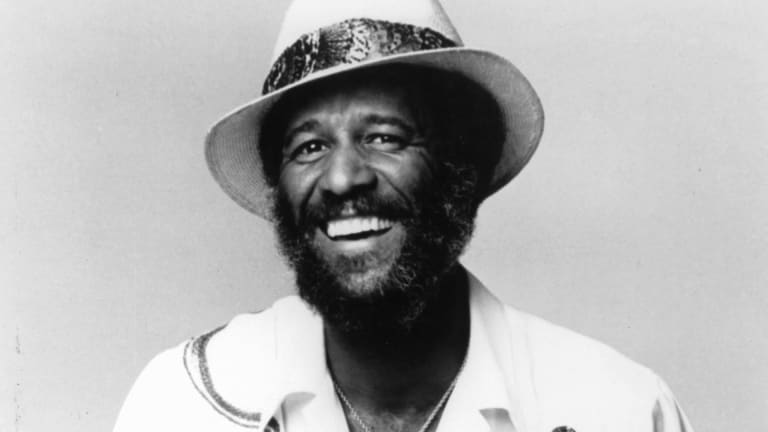
When it comes to feelings about Famous Amos, I imagine people typically fall into one of three groups:
The first group—being made up of mostly young people (probably; I’ve no data)— has zero knowledge of the brand at all. If the name doesn’t conjure visions of second-rate vending machine options (D4 at best), then you’re likely in this group.
The second group knows of Famous Amos and is familiar with its underwhelming status as a dollar store checkout counter snack food. Reasonable.
But the third group has a different view of the matter. A much more romantic take on the treat. Because this group remembers Famous Amos as a mouthwatering gourmet delicacy. A top-shelf cookie purveyor with an outspoken, charismatic owner in Wally Amos.
Why such a harsh disparity? How can a company less than 50 years old have such contradicting reputations among different generations?
There was a time, just a few decades ago, when Amos was a household name. A successful brand with big-name celebrity investors, upscale distribution, and a first-year total sales revenue of $300,000.
But by the mid-80s, the brand was hemorrhaging money. Amos would lose his house and eventually sell a majority stake of the company. Many people were left to wonder: How did one of the most successful snack companies of the last decade so quickly decay into financial shambles?
How did Amos find himself on the butt-end of a bad break?
These are interesting questions, and sure to be answered. But first, it’s worth understanding Famous Amos’ rise to popularity, understanding what made this gourmet cookie company so successful, so, well— I’m not gonna say it, I am not going to—famous.
Wally Amos’ Rise to Fame
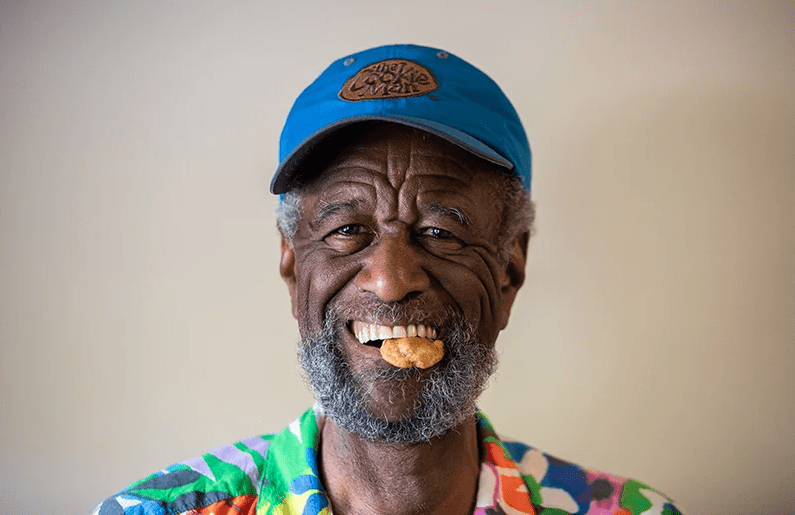
Wally Amos came from a classically humble upbringing, born in 1936 in Tallahassee, Florida, to poor, illiterate parents. At age 12, he moved to New York to live with his Aunt Della. It was here that he learned of the famous recipe. (More on this in a bit.)
Amos, who dropped out of high school, would receive his G.E.D. after joining the Air Force. Returning to New York as a mature, educated man, he found work in the William Morris Agency, a Hollywood-based talent agency once considered “the best in show business.”
He began in the mailroom, eventually working his way up to becoming the first black talent agent in the entertainment industry.
This was more than just a side-quest for an aspiring baker; Amos now headed the rock’n’roll department at William Morris, where he signed Simon and Garfunkel and worked with Motown legends like Diana Ross, Sam Cooke, and Dionne Warwick.
It was only after growing disillusioned with the industry that Amos sought refuge in his aunt’s baking once more.
Wally’s son, Shawn Amos, said:
“Cookies were a hobby to relieve stress.”
It wasn’t long before the cookies took the main stage.
Amos told The New York Times in 1975:
“I’d go to meetings with the record company or movie people and bring along some cookies, and pretty soon everybody was asking for them.”
Amos’s connection with the entertainment business helped his business aspirations tremendously. He received significant contributions from industry stars Marvin Gaye and Helen Reddy, who gave Amos $25,000 for his new venture.
In 1975, Amos launched his first brick-and-mortar location. 7181 Sunset Blvd. in Los Angeles.
And it was a big deal. The grand opening was a star-studded gala attended by 1,500 people.
Success was sudden. After selling $300,000 worth of cookies in its first year, the brand continued to climb in popularity. By 1982, Famous Amos was making $12 million in yearly revenue.
Famous Amos’s success was the result of exploiting a hole in the market. In the mid-70s, the grocery store shelves were loaded with preservative-dependent snack options. Amos carved out a lucrative niche by marketing the product as a gourmet, zero-preservative, craft-made cookie. A risk well rewarded.
From “What’s Going On?” to “What’s Going On???”

With any great market advancement, a plethora of eager competitors emerge. And shortly after arriving on the scene, Famous Amos was met with rival brands like Mrs. Fields, and new, upmarket product lines from Nabisco and Duncan Hines.
Combining these market competitors and Amos’s inability to keep up with his success led to the first cracks in the business. By 1985, Famous Amos reported a $300,000 loss on sales of $10 million.
Later that year, Amos officially gave up the reigns of his company, selling a majority stake to Bass Brothers Enterprises for $1.1 million.
Two years later, the new owners upended the recipe entirely, adding preservatives and shelf-stable ingredients. Famous Amos was rebranding as an affordable brand. It wasn’t entirely unexpected; such mission-statement-defying practices are common for newly bought companies, but the decision prompted original owner Wally Amos to depart.
In 1992, President Baking Company bought Famous Amos for $61 million—more than 55 times what Wally Amos sold his controlling stake for just a few years earlier.
Amos wasn’t through with the cookie business, however. Later in 1992, he launched his new venture…
And was promptly sued.
Turns out: the latest Amos product— Wally Amos Presents Hazelnut Cookies— stood in direct violation of the contract he had signed years prior when selling his first business. The one that expressly prohibited Amos from using his own name and likeness in the selling of any product.
Undeterred, he changed the name of his company, operating instead as Uncle Nonamé. Boldness had treated him well in the past— and I think it’s an undeniably ballsy way to approach being sued over your own identity— but the market operates in mysterious ways. In 1996, Uncle Nonamé filed for bankruptcy.
What Became of Wally Amos?
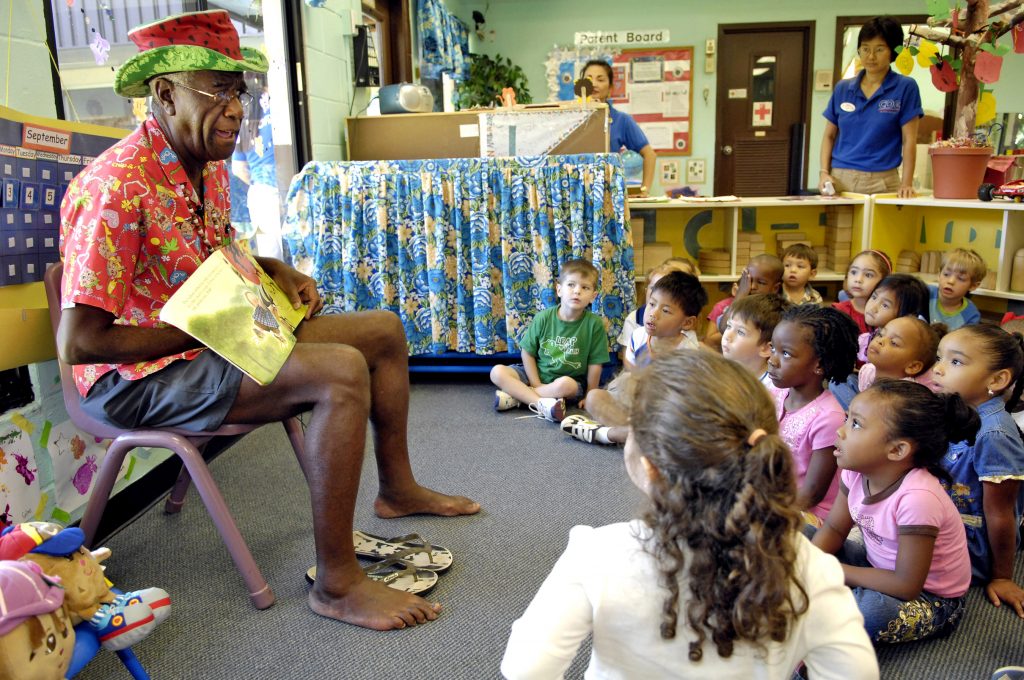
By 1999, Amos was in talks with Keebler, the new owner of Famous Amos. An agreement had been reached: Wally Amos would become a paid spokesperson for the brand under the condition that they craft the recipe closer to the original.
And it feels like a solid ending to the story. The sweet embrace of a father and son after a long, arduous journey, complete with lawsuits, bankruptcies, and foreclosure. Ending up together would be fitting— if a bit too good to be true.
“It was bittersweet,”
says his son, Shawn Amos.
“He was happy to be back in the center of the brand he started, but he also had a hard time accepting the fact that at the end of the day, he was just a paid spokesperson.”
The feeling of being alienated from one’s own brainchild eventually led to a short-lived reunion between Amos and the brand that bears his name.
After leaving once and for all, Amos pivoted to making muffins with Uncle Wally’s Muffin Co., opening a bake shop in Hawai’i.
Amos wrote multiple books about his experience over the years, including Power In You, Man With No Name: Turn Lemons into Lemonade, and The Famous Amos Story: The Face That Launched 1,000 Chips. He has also been a vigorous advocate for literacy and was granted a National Literacy Honors Award by President George H.W. Bush.
At age 80, Amos appeared on the hit television show, Shark Tank, pitching another new business, “The Cookie Kahuna”. The business ultimately failed.
In 2017, he launched a GoFundMe, announcing he was struggling to pay for food, gas, and rent.
No longer famous, Wally Amos continues on with his baking and entrepreneurial spirit. His life is a statement of hard work and resilience, but also a cautionary tale about success, hubris, and the risks we make along the way.
Business
What’s an MLM? How Does It Work and Why Is It Controversial?
Published
1 week agoon
May 22, 2025
Browsing Reddit has become a recent pastime because of a few hilarious and scandalous stories about people promoting MLMs. Then, going through YouTube offered me the same thing: the rise of terrible business practices of multi-level marketing companies.
While entertaining, I cannot help but feel a sense of sadness for these people who are swept up in these cult-like networks. I went to find out more and see what an MLM is exactly and why many are sacrificing their livelihoods for it.
The Structure

If you’ve been online within the past decade, there’s a good chance you’ve heard of the term “MLM.” However, you might not know exactly what it means. Well, I’ll put things into perspective for you. If you ever encountered cryptic Facebook or Instagram message asking you to buy some products, host a party, or join some kind of “exclusive” business, then you’ve had a firsthand encounter with an MLM. Congrats… I guess.
These messages, creatively nicknamed “hunbots,” are often sent by friends, family, or other mutuals. And if you got an iffy feeling while reading them, that’s because these users are caught up in a very common marketing scam. As mentioned before, the term “MLM” is an acronym that stands for Multi-level Marketing. You may also know it as network marketing or a pyramid scheme.
Well-known MLM companies include LuLaRoe, Mary Kay, Avon, Amway, and Herbalife. (And there’s more where that came from, unfortunately)
The Pyramid
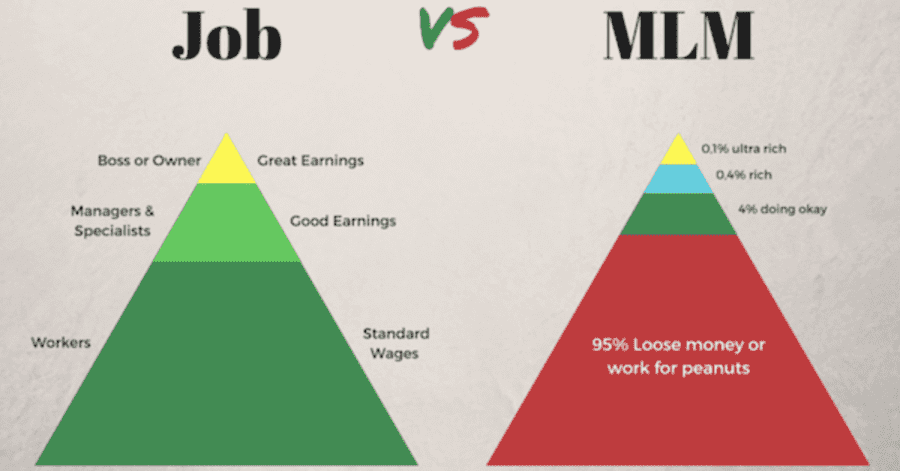
I really like the use of the term “pyramid scheme” because when you look at the structure of these companies, they follow or format that is shaped like a pyramid. The higher-ups at the top are comprised of a very small number of people. Meanwhile, there’s a sh*tton of struggling workers at the bottom, all with lost Investments and broken promises.
Let’s say there’s one businessman at the very top of this pyramid. As the head of the company, he hires two more employees under him. These employees must pay an entry fee in order to join the company. Afterward, they are given products to sell, and some of the proceeds go to the big boss. These other two employees hire their own employees to work under them. Same deal; the employees on the third level show the products, and most of that money makes its way up to the one at the top. The cycle goes on and on and on to form a pyramid.
The Typical Experience

So, how does this work from the average MLM employee’s perspective? Put yourself in the shoes of someone who just got sucked into an MLM. I know, it’s terribly cringeworthy, but bear with me.
So, you’re a new recruit. You must pay an entry fee to join this exclusive establishment. The cost may vary, but usually, the more you pay, the more benefits you receive.
You’ll then be given products to sell. You may have to pay a fee to get these products into your hands. You might have to sell them at a higher cost than their unit price. But here’s the deal: more emphasis is placed on the action of recruiting more members. You will get paid in commission for every new member that you recruit. And guess what they will do with new members? They’ll be asked to pay entry fees just like you, and go on to try to recruit new members themselves. The way the system works is that it benefits only the higher-ups and early recruits. Hence, they call it an MLM. It’s got multiple levels, and the higher up you go, the more you’ll benefit at others’ expense.
What these companies won’t tell you is that new members are their main source of income. When new recruits run low, that’s when the company starts crumbling down. And once that company crumbles, the early recruits and CEOs collect their money, while regular employees are left broke.
The Manipulation
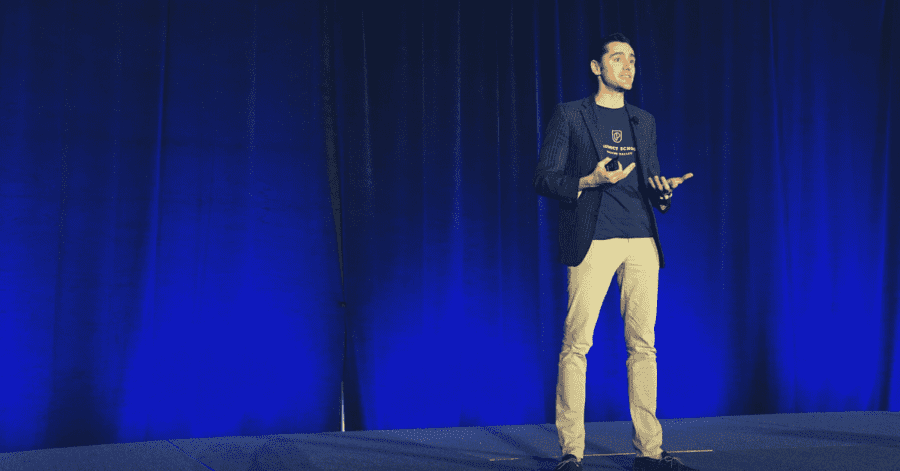
To most people, spotting these MLM companies is pretty easy. A job offer that charges entry fees, has a vague company set-up, or has no adequate interview process is naturally going to raise some alarm bells. So, you might be wondering: how the hell do people fall for these things?? Aren’t they obvious scams?
In truth, it’s not obvious to many demographics. And if you happen to get swept up in an MLM, it’s really hard to get out. Unfortunately, the only reason these businesses still exist is that people keep falling for them.
Strategies

There are three strategies that MLMs use when recruiting people;
- Targeting certain demographics
- Using charisma and big promises
- Giving people a sense of belonging
Let’s circle back to the “hunbots.” Ever wonder why those MLM messages will often use this upbeat “girl boss” language? Well, that’s because most of these companies are created to appeal to young college girls and middle-aged women. Young adults sometimes don’t have enough life experience to notice when they’re being scammed. Meanwhile, some older people don’t have enough tech-savviness to notice online ploys. Many women enjoy the idea of becoming their own boss and achieving a sense of empowerment.
Of course, many men fall for this as well. Normal jobs can be sucky. Sometimes you just wanna make easy money on your own schedule. Especially when the companies in question promise big returns while working on your own schedule. MLMs will often have spokespeople who can convince you to care about their cheap leggings or mediocre supplements.
Once they get reeled into the business, MLMs will host social events that provide a personal connection to other employees and higher-ups. They’ll start to form a bond with these people, until they become almost like a family. Remember that job you wanted to quit and knew you should quit, but the people were so nice that you just…had a hard time? Well, it’s that time 1000, because by this point, you’ve already invested so much money and time into them.
I’ve read so many horror stories of people losing their cars, their houses, their kids, all in the name of some cheap makeup products.
Business
Loom Review: Features, Use Cases, and How It Stacks Up Against Zoom
Published
1 week agoon
May 21, 2025
Are you tired of keeping up with long email chains or trying to sync everyone in the team for a live call? If you answered yes, then Loom could be an efficient tool for you. In this Loom review, we’ll unpack how you can use Loom to explain complex ideas, give feedback, or walk someone through a task without going on a live call.
We’ll also explore its standout features, use cases, pricing plans, and how it compares to Zoom so you can decide if it fits your team’s workflow.
What is Loom?
Loom is a video messaging app that lets users record and share video messages with teammates and clients. Using Loom, you can record your camera, microphone, and desktop screen at the same time.
According to online Loom review, this is especially useful for individuals to create tutorials, demonstrations, and presentations, as well as to share feedback.
Loom users can choose to record with the Loom Chrome extension, the desktop app, as well as the iOS and Android apps.
Some of Loom’s clients include Brex, Intercom, Postclick, and more.
Loom Features
Loom has various features that allow it to seamlessly integrate into a company’s existing workflows.
Users can play Loom download videos within platforms like:
- Slack
- Jira
- Confluence
- Github
Why does this matter? Users will no longer be led to an external link, increasing their productivity by playing feedback videos within the platform.
Next, Loom video has an AI suite that can help teams work more efficiently. Using AI, the tool can:
- Automatically generate meeting notes and recaps, among other things
- Instantly create chapters in your videos, as well as CTAs and tasks
- Create text transcription and generate closed captions
To refine your videos further, Loom has features that can remove filler words and silence in a video.
Besides this, Loom also has a video-to-text feature. This is especially useful for asynchronous teams that need help with logging a bug issue, documenting a process, or performing a code review.
Loom Pricing
Loom pricing is generally straightforward. If you want to know if Loom is free, yes, it does have a free tier.
It has a free Starter plan for users who want to try out the app’s key features. It can accommodate up to 50 Workspace users, who are each entitled to up to 25 videos with a five-minute length cap.
Next, the Business plan is for teams that want unlimited videos and basic editing. It costs $15 per user per month if billed annually. Here, you can have unlimited members get basic waveform editing, remove the Loom Branding, and more.
According to Loom review, their most popular plan is the Business + AI plan, where teams can get advanced editing and access their AI suite. This plan costs $20 per user per month if billed annually.
Their premium plan is the Enterprise plan, which is best for companies that want to control and securely manage video content for the organization. If you’re wondering, “Is Loom safe to use?” This plan has advanced security and content privacy features as well as admin insights. Teams need to contact Loom’s sales team first to get a price quote.
Finally, Loom has a discount plan for educators as part of the Atlassian Education Program.
Use Case Breakdown
Here are a few Loom use cases:
- Loom review can be especially helpful for tech teams, as it can be used to narrate a bug issue. When an issue occurs, developers or testers can simply record the issue with Loom and report the issue to the concerned developers. It saves time and increases the turnaround time for bug fixes.
- Hiring teams and internal teams can also use Loom to document an internal process for onboarding purposes. Apart from this, it can also be used by customer-facing teams to create user guides on a platform or a new product feature.
- Sales teams can also use Loom to reach out to prospective clients. When cold emails are not friendly enough, sales teams can create personalized video content through Loom and stand out.
- Taking too long to get feedback from all stakeholders? Loom is great for product design teams to get asynchronous feedback from a global executive team. It’s great for instances where it’s difficult to get stakeholders in one meeting.
- Finally, Loom is great for educators and academics who want to create videos for remote classes.
Loom vs. Zoom
While their names sound the same, Loom and Zoom have different fundamental use cases. In terms of Loom review, Loom is best used to record and send videos, which can be used for demos, tutorials, and feedback. In terms of use cases, Loom is more catered to asynchronous communication and screen recordings.
Meanwhile, Zoom is best used for hosting live meetings and large conferences. It has features like breakout rooms and virtual backgrounds. While you can use Zoom to record videos yourself, Loom is more optimized to share video links with teammates and clients.
Final Thoughts: Who Will Get the Most Out of Loom?
Loom is best for companies that need videos for their day-to-day work communication. Whether for external or internal communication, it is great for clients who work asynchronously. In fact, most of their clients include those in the tech and product space.
Their product is useful for tech, sales, and product design teams that need to align with cross-functional teams. Loom is also best for companies that want to tighten their internal feedback loop, demonstrate processes, and get quick updates.
Educators, coaches, and course creators can also benefit from Loom’s features. The platform makes it easy to create clear, engaging instructional videos that students or clients can watch at their own pace. With features like closed captioning, video chapters, and transcription, Loom helps streamline learning and knowledge sharing.
Finally, to sum up this Loom review, freelancers and consultants who want to build stronger relationships with clients may also find Loom useful. Just like gadgets that boost team connectivity, like the Deeper Connect Pico, the global workforce can benefit a lot from Loom. Personalized video updates, walkthroughs, or proposals can set them apart, adding a human touch to digital communication that static emails or text-based reports often lack.

BeReal App: Will It Survive Its Instagram Clone?

Lesbian Bars Were Dying. Now They’re Making a Comeback

Wally Amos: From Cookie Mogul to Life’s Tough Lessons

What’s an MLM? How Does It Work and Why Is It Controversial?

Loom Review: Features, Use Cases, and How It Stacks Up Against Zoom

Explained: What Is the Deeper Connect Pico and How Does It Work?

The 10 Best Gifts for Coffee Lovers

Wally Amos: From Cookie Mogul to Life’s Tough Lessons

Lesbian Bars Were Dying. Now They’re Making a Comeback

BeReal App: Will It Survive Its Instagram Clone?

Loom Review: Features, Use Cases, and How It Stacks Up Against Zoom


